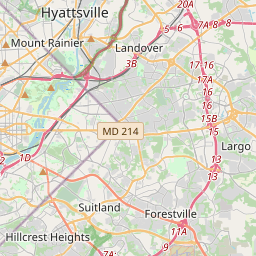Inscription
Alexandria Heritage Trail
—City of Alexandria Est. 1749 —
Phoenix Mill is the last surviving remnant of Alexandria's once thriving milling industry. William Hartshorne built the four-story mill in 1801. The mill was built at a time when Northern Virginia's economy shifted from tobacco to grain production, and flour and wheat were the principal export products of Alexandria's ports. The Phoenix Mill produced flour and feed, as well as ground lime for plaster. Water diverted from Holmes Run powered the mill's overshot waster wheel. The 19-foot diameter wheel turned the mill's four pairs of millstones.When David Watkins purchased the mill in 1854, he renamed it Dominion Mill. Watkins replaced the original water wheel with a 40½-foot wooden wheel (pictured above). He later added a second 40½-foot wheel made of metal that more than doubled the mill's power. The mill produced flour, rye, and mixed feed, as well as ground coffee. Watkins' mill appears as Dominion Grist Mill on the 1878 Hopkins atlas (see detailed map) and as Old Dominion Mills in an 1888 advertisement (see detail). The mill continued to operate as Dominion Mill for another 33 years after Watkins' heirs sold the mill in 1888. In 1921, the Dominion Mill ceased operation as a grist mill. Later owners of the mill used the building as commercial office space, helping to preserve this piece of Alexandria's past.
Water
Power. Overshot water wheels such as those used at Phoenix Mill were one of the most common methods for powering mills. As the name suggests, overshot water wheels receive their water from an overhead sluice that empties directly onto the forward part of the wheel, filling the wheel's buckets and causing the wheel to turn by force of gravity as the water drops. Improvements in wheel design eventually led to an innovative cured-bucket design that was more efficient than traditional straight-sided buckets. When Dominion Mill needed to replace its aging wooden water wheel in 1909, the owners installed a curved-bucket Fitz I-X-L Overshoot Water Wheel designed by John Fitz.
Millstones. Phoenix Mill had four pairs of millstones. The stones would have weighed from one to two tons each. Grooves chiseled into the grinding surfaces cut and ground the grain. Only the upper millstone in a pair turned. The lower or bed stone was fixed in place. It was the miller's job to see that the millstones were set properly, with no more than a paper's width between the grinding surfaces, and that the grinding surfaces were kept sharp.
Details
| HM Number | HM2GV7 |
|---|---|
| Tags | |
| Year Placed | 2008 |
| Placed By | City of Alexandria |
| Marker Condition | No reports yet |
| Date Added | Saturday, May 18th, 2019 at 8:01am PDT -07:00 |
Pictures
Locationbig map











| UTM (WGS84 Datum) | 18S E 318158 N 4297483 |
|---|---|
| Decimal Degrees | 38.80736667, -77.09421667 |
| Degrees and Decimal Minutes | N 38° 48.442', W 77° 5.653' |
| Degrees, Minutes and Seconds | 38° 48' 26.52" N, 77° 5' 39.18" W |
| Driving Directions | Google Maps |
| Which side of the road? | Marker is on the right when traveling East |
| Closest Postal Address | At or near , , |
| Alternative Maps | Google Maps, MapQuest, Bing Maps, Yahoo Maps, MSR Maps, OpenCycleMap, MyTopo Maps, OpenStreetMap |
Is this marker missing? Are the coordinates wrong? Do you have additional information that you would like to share with us? If so, check in.
Maintenance Issues
- What country is the marker located in?
- Is this marker part of a series?
- What historical period does the marker represent?
- What historical place does the marker represent?
- What type of marker is it?
- What class is the marker?
- What style is the marker?
- Does the marker have a number?
- This marker needs at least one picture.
- Can this marker be seen from the road?
- Is the marker in the median?

Comments 0 comments